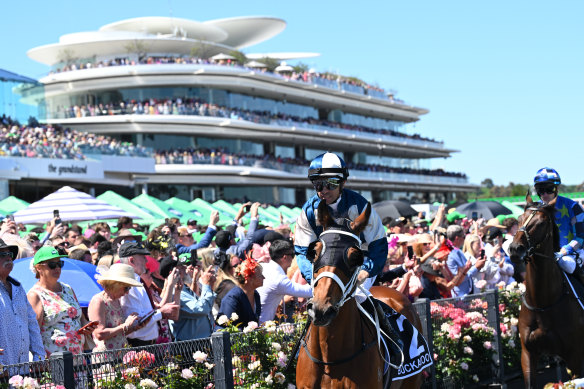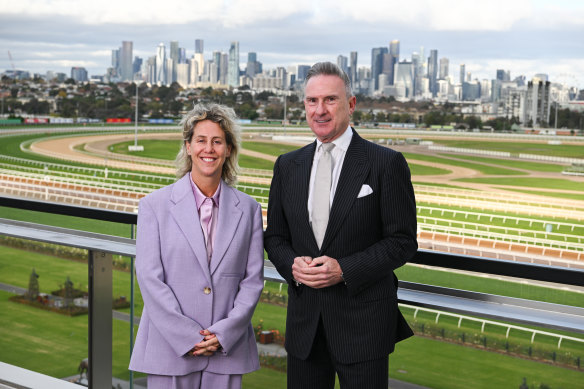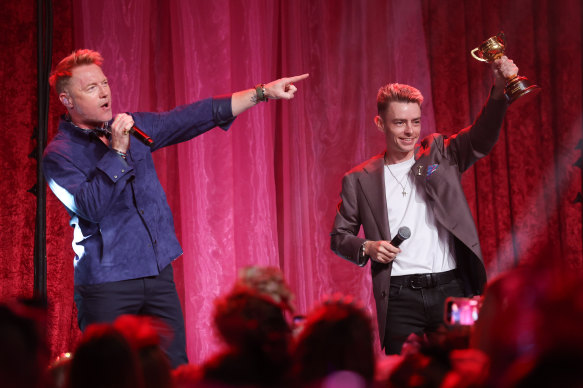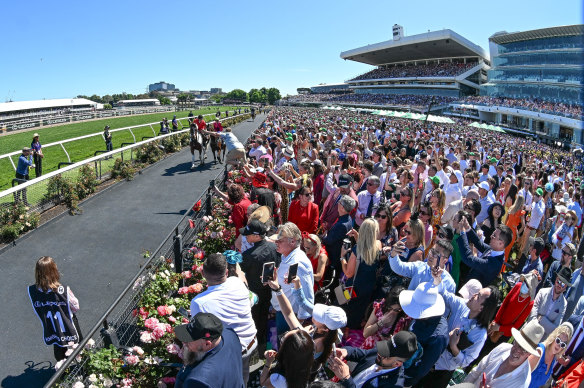Victoria Racing Club to slash jobs just weeks after bumper Cup carnival
Just weeks after basking in the glory of a bumper Melbourne Cup carnival, the Victoria Racing Club is preparing to slash staff numbers as it attempts to reel in years of spiralling debt.
Two senior industry sources not authorised to speak on behalf of the club said the VRC, which oversees Flemington racecourse, was looking to cut between 30 and 40 per cent of its workforce.

Moreira and Buckaroo head out to the start gate for the Melbourne Cup.Credit: Getty Images
The VRC did not acknowledge this figure when approached for comment.
The club is besieged by debt, reporting losses of $16.9 million and $14.9 million for the 2022 and 2023 financial years, and has borrowed $75 million from ANZ. It separately owes Racing Victoria $10 million.
The VRC is expected to release its annual report for the 2024 financial year next week.
While the VRC has fluctuating staff numbers to cope with spring and autumn carnivals, the club says on its LinkedIn page that it employs more than 200 permanent people year round.
News of the looming job cuts comes just weeks after Flemington hosted its most successful Melbourne Cup week carnival since 2018.
A crowd of 285,675 attended the four days – Victoria Derby day (81,612), Melbourne Cup day (91,168), Oaks day (50,873) and Champions day (62,022).
The club, which has just started a lucrative broadcasting deal with Channel Nine, the owner of this masthead, said its showcase week had delivered more than $468 million to the Victorian economy.
But Flemington has continued to carry huge debt since borrowing heavily to open a $128 million grandstand in October 2018.

The Victoria Racing Club announced Kylie Rogers, pictured with VRC chairman Neil Wilson, as its new chief executive in June.
The club was then hit by the COVID-19 pandemic, which wiped out crowds.
“The Victoria Racing Club has not been immune to rising costs across the supply chain required to deliver more than 20 Flemington race days, including the four days of the Melbourne Cup carnival,” the club said in a statement on Wednesday.
“While the 2024 Melbourne Cup carnival saw increased crowds and viewing audiences, the VRC conducts regular reviews of its cost base to ensure we have the right long-term strategy and operating plan in place to deliver future growth.”
The club incurs significant expenses to promote and stage the Melbourne Cup carnival, including a Cup tour that circles the globe, paying big international acts to perform during the carnival and staging several Cup week functions, including hosting 1250 guests at the Crown Oaks luncheon.
In last year’s annual report, chairman Neil Wilson, who also served as VRC chief executive from January 2018 to November 2020, said Melbourne Cup week was the No.1 “economic generator” of any Australian sporting event, but he did not acknowledge the club’s ongoing debt.
VRC chief executive Kylie Rogers, who started in the role on September 1, said in an October interview that the club had a “clear desire to be financially independent”.
She said the club had to reduce its cost base as well as focus on “revenue generation” for core race days and non-race days.
The VRC is part of a larger racing industry looking to embark on major cost-cutting as the state’s three codes – gallops, harness and dogs – feel the financial squeeze.

Irish singer Ronan Keating and Melbourne Cup-winning jockey Robbie Dolan.Credit: Lucas Dawson
This masthead reported on Monday that the cost-of-living crisis and a drop in wagering turnover had resulted in the three codes losing a combined $58 million in the past financial year.
Racing Victoria chief executive Aaron Morrison said his industry would be looking to save $10 million over the next 12 months by streamlining its media businesses as well as reviewing race programming.
He said Racing Victoria was in talks with the trainers’ association about the possibility of more race-free days, and was speaking to clubs about sharing resources, such as marketing, catering and back of house.
Racing Victoria is also conducting an in-depth review of the more heavily subsidised jumps racing, which will be finalised by the end of November.

Record crowds attended the spring carnival at Flemington.Credit: Joe Armao
The Victorian government said it would “always back the sustainability” of the racing industry, which it said generated $4.7 billion for the economy and helped sustain almost 35,000 full-time jobs.
“We are working with all three racing codes to ensure their continued success,” a government spokesperson said.
“A new funding framework has been put in place that includes an increase in the point of consumption tax from 10 per cent to 15 per cent.
“After the increase, the racing industry’s share of revenue will be 7.5 per cent of the 15 per cent [tax].”
Rising costs and diminishing returns forced a new-look board at Melbourne Racing Club to scrap decade-old plans to build a $250 million grandstand at Caulfield because of the financial pressure it would place on the club.
Moonee Valley is pushing on with plans to reshape its track and build a new grandstand after next year’s Cox Plate, which would form part of a total project cost between $200 million and $250 million.
The Valley posted a $12.4 million loss in the past financial year, but poured money into construction of its Moonee Valley Park project – an investment that was expected to reap greater dividends when completed properties were sold in following years.
Wagering from July 1 is down 9 per cent, and wagering for the spring carnival (from August 31) is down 8.2 per cent. But the spring attendance is up 4.4 per cent (504,916). Turnover for the Melbourne Cup was expected to be $215 million – five times the next biggest race turnover, which is the Cox Plate.
News, results and expert analysis from the weekend of sport are sent every Monday. Sign up for our Sport newsletter.